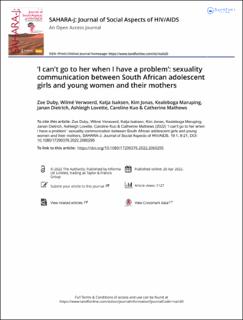| dc.description.abstract | Parent–adolescent sexuality communication, the process in which parents and their adolescent children discuss sexuality and sexual and reproductive health, is a key component for adolescents’ protective behaviours. Open communication with parents, particularly mothers, enables informed sexual and reproductive health (SRH) decision-making amongst adolescent girls and young women (AGYW). As part of a qualitative study evaluating a South African combination HIV prevention intervention for AGYW, we explored perspectives on SRH communication among AGYW and mothers of AGYW, and the effects of the intervention on sexuality communication as perceived by AGYW, mothers of AGYW, intervention facilitators and implementers, and community leaders. In-depth interviews and focus group discussions were conducted with 185 AGYW aged 15–24 years who had participated in the intervention, seven mothers of AGYW intervention recipients, 14 intervention facilitators, six community leaders, and 12 intervention implementers. Key themes that emerged in analysis were (1) Barriers to Sexuality communication, (2) Implications of Gaps in Sexuality Communication, and (3) Addressing Barriers to Sexuality communication. Barriers to sexuality communication included inability or unwillingness to discuss sex, a generation gap, proscriptive socio-cultural guidelines, and mothers’ discomfort, lack of knowledge and self-efficacy, and fear of encouraging promiscuity. AGYW described making poorly-informed SRH decisions alone, expressing a desire for more open communication with and support from parents/mothers. Framed within the social cognitive theory, these findings can help to guide efforts to address barriers around parent–adolescent sexuality communication, inform interventions aimed at targeting SRH issues amongst AGYW, such as unintended pregnancy and HIV, and support meaningful engagement of parents in supporting AGYW in navigating pathways to achieving their SRH goals. | en_US |

